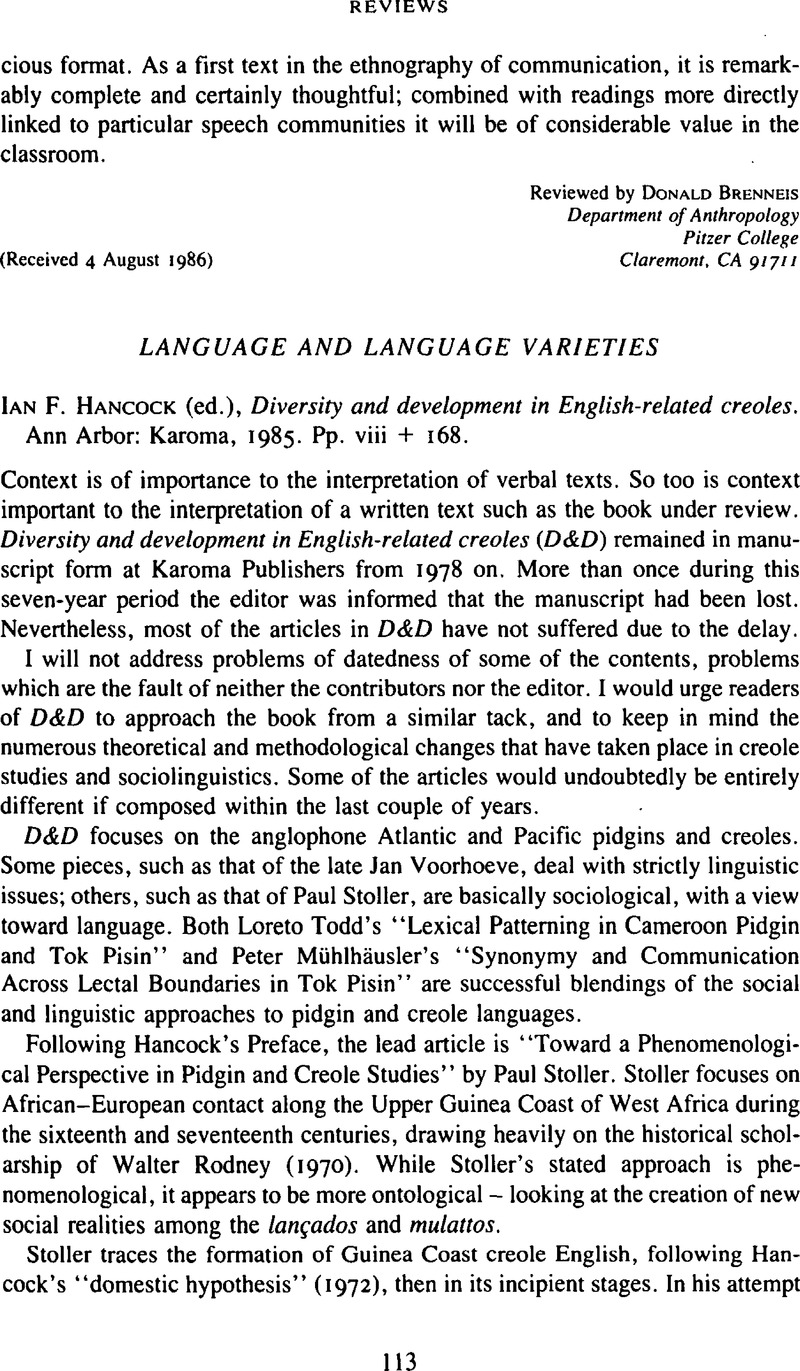No CrossRef data available.
Article contents
Language and Language Varieties - Ian F. Hancock (ed.), Diversity and development in English-related Creoles. Ann Arbor: Karoma, 1985. Pp. viii + 168.
Review products
Ian F. Hancock (ed.), Diversity and development in English-related Creoles. Ann Arbor: Karoma, 1985. Pp. viii + 168.
Published online by Cambridge University Press: 18 December 2008
Abstract
An abstract is not available for this content so a preview has been provided. Please use the Get access link above for information on how to access this content.

Information
- Type
- Book Review
- Information
- Copyright
- Copyright © Cambridge University Press 1987
References
REFERENCES
Day, R. R. (ed.) (1980). Issues in English Creoles. Papers from the 7975 Hawaii Conference. (Varieties of English Around the World: General Series, 2.) Heidelberg: Julius Groos.CrossRefGoogle Scholar
DeCamp, D. (1971). Toward a generative analysis of a post-creole continuum. In Hymes, D. (ed.), Pidginization and creolization of languages. Cambridge University Press. 349–70.Google Scholar
Hall, R. (1977). The staging of the development of English phonology 1600–1700: Some Creole evidence concerning /ŋ/. In Meisel, J. (ed.), Langues en contact – pidgins – Creoles – languages in contact. Tübingen: Gunter Narr. 55–80.Google Scholar
Hancock, I. (1972). A domestic origin for the English-derived Atlantic Creoles. Florida FL reporter 10: 7, 8, 52.Google Scholar
Hancock, I. (1980). Lexical expansion in Creole languages. In Valdman, A. & Highfield, A. (eds.), Theoretical orientations in create studies. New York: Academic. 63–88.Google Scholar
Hancock, I. (1985). The domestic hypothesis, diffusion, and componentiality: An account of Atlantic anglophone Creole origins. Paper presented at the Workshop on Universals vs. Substrata in Creole Genesis, The University of Amsterdam, April.Google Scholar
Hancock, I. (1986). A preliminary classification of the Atlantic anglophone Creoles. In Gilbert, G. (ed.), Pidgin and Creole languages: Essays in memory of John E. Reinecke. Honolulu: University of Hawaii.Google Scholar
Lawton, D. (1980). Language attitude, discreteness, and code-shifting in Jamaican Creole. English World- wide 1: 211–26.CrossRefGoogle Scholar
Lawton, D. (1982). English in the Caribbean. In Bailey, R. & Gorlach, M. (eds.), English as a world language. Ann Arbor: University of Michigan.Google Scholar
Le Page, R. (1957/1958). General outlines of Creole English dialects in the Caribbean. Orbis 6: 373–91 and 7: 54–64.Google Scholar
Le Page, R. (1980). Projection, focussing, diffusion. York Papers in Linguistics 9: 9–31.Google Scholar
Le Page, R., & Tabouret-Keller, A. (1985). Acts of identity: Creole-based approaches to language and ethnicity. Cambridge University Press.Google Scholar
Williams, J. (1986). The place of women and kinship in Creole genesis. International Journal of the Sociology of Language. Special issue: “Sociolinguistics and pidgin and Creole studies,” ed. by J. Rickford.Google Scholar

